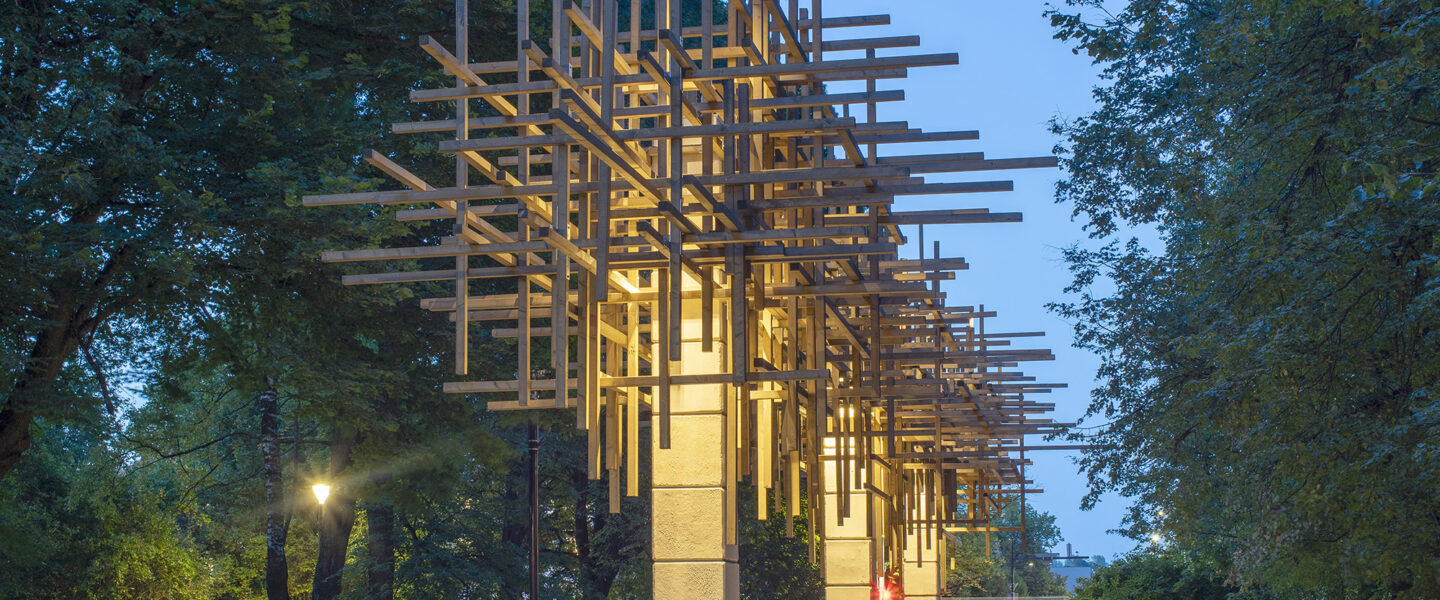
Shelter Linnutee, 2023. Photo by Paco Ulman
On July 27, 2023, architecture students from EKA unveiled the “Milky Way / Linnutee / Road of Birds,” a high-rise structure designed for birds in Tartu Ülejõe Park. The completion of this construction project marked the end of the first year of studies for the students.
Normally, first-year EKA students build shelters for people by the end of the academic year. However, this year’s project focused entirely on birds. According to the author of the “Milky Way,” Artur Raik, the structure highlights how architecture is increasingly emphasizing coexistence with other forms of wildlife. Raik explained, “The completed ‘Milky Way’ is a good example of how the human-made environment can also consider the needs of other species. Our work provides nesting places for birds, shields them from direct sunlight, and protects them from predators. Hopefully, it also provides an interesting change for the human eye.”
During the construction, which lasted for a total of 10 days, the students had to prepare both the construction site and build 12 nesting apartments. Raik said, “None of us had much construction experience, so it was quite a challenge to perform all the tasks in accordance with safety requirements. For instance, figuring out how to securely attach beams at a height of seven meters when the wooden structure becomes slippery due to rain. Certainly, our time spent in Tartu took us out of our comfort zone.”
Sille Pihlak, the dean of EKA’s Faculty of Architecture, stated that such construction projects are essential for first-year students on their journey to becoming architects. She said, “The shelter project combines theory and practical construction. To gain a complete overview of the architect’s profession, young students need to personally experience the spatial creation processes from generating ideas to opening a structure. Along the way, students also get to know each other better, which leads to important connections for their professional careers.”
According to the dean, this year’s project has also aptly captured the changes in future architectural principles. She stated, “Architecture’s task is to create infrastructure for a different kind of nature than humans. It is the students’ task to critically raise questions and provide solutions on how the built environment can be beneficial to all, whether it’s wildlife corridors, green spaces, or, in this case, birdhouses. I think they have done an excellent job with that.”
Tartu Deputy Mayor Meelis Leidt praised the collaboration between Tartu and EKA in shaping an intelligent and biodiverse urban environment during the opening ceremony. Tartu Deputy Mayor Elo Kiivet mentioned that the students’ work introduces opportunities for enriching the urban environment for the residents of Tartu. She said, “Tartu is always open to initiatives that activate the cityscape and engage its residents. Previous shelters have proven that young students have a good understanding of how to make the living environment more exciting and inclusive for city dwellers. Thanks to the Estonian Academy of Arts, birds now also have a better place to live, which can bring joy to people as well.”
The design and planning team of the EKA Architecture and Urban Planning first course included Artur Raik, Ralf Tõra, Keijo-Johann Norden, Raimond Vool, Kelly Grahv, Keidi Kaasik, and Saskia Krautman.
Construction was carried out by Anett Maiste, Carolyn Vilk, Samuel Eff Markkus Savimägi, Elisabeth Tomingas, Hanna Eliise Kitter, Ines Ollisaar, Kertu Kullas, Kirke Kivisoo, Maksimilian Karetin, Marian Reva, Elise Lissel Pähkel, Rigo Sildoja, Aleksander Siim, Sofia Schneider-Sepping, and Karl Perens.
The project was supervised by Ott Alver and Alvin Järving from the architecture firm Arhitekt Must, and woodworking guidance was provided by Ragnar Kekkonen, while Andres Lehtla guided the students in the construction aspects. This year’s shelter is already the third EKA student project to be completed as part of Tartu 2024 European Capital of Culture, and the 18th such small-scale project overall.
The completion of the shelter was supported by the city of Tartu, the Estonian Cultural Endowment, the Estonian Forest and Wood Industry Association, the Environmental Investment Centre, Kotton Betoon, Raitwood, ITK Lighting, Hektor Light, and Rothoblaas.
More information about the shelter series and all the objects built so far can be found here: https://www.artun.ee/en/curricula/architecture-and-urban-design/new-works/shelters/
